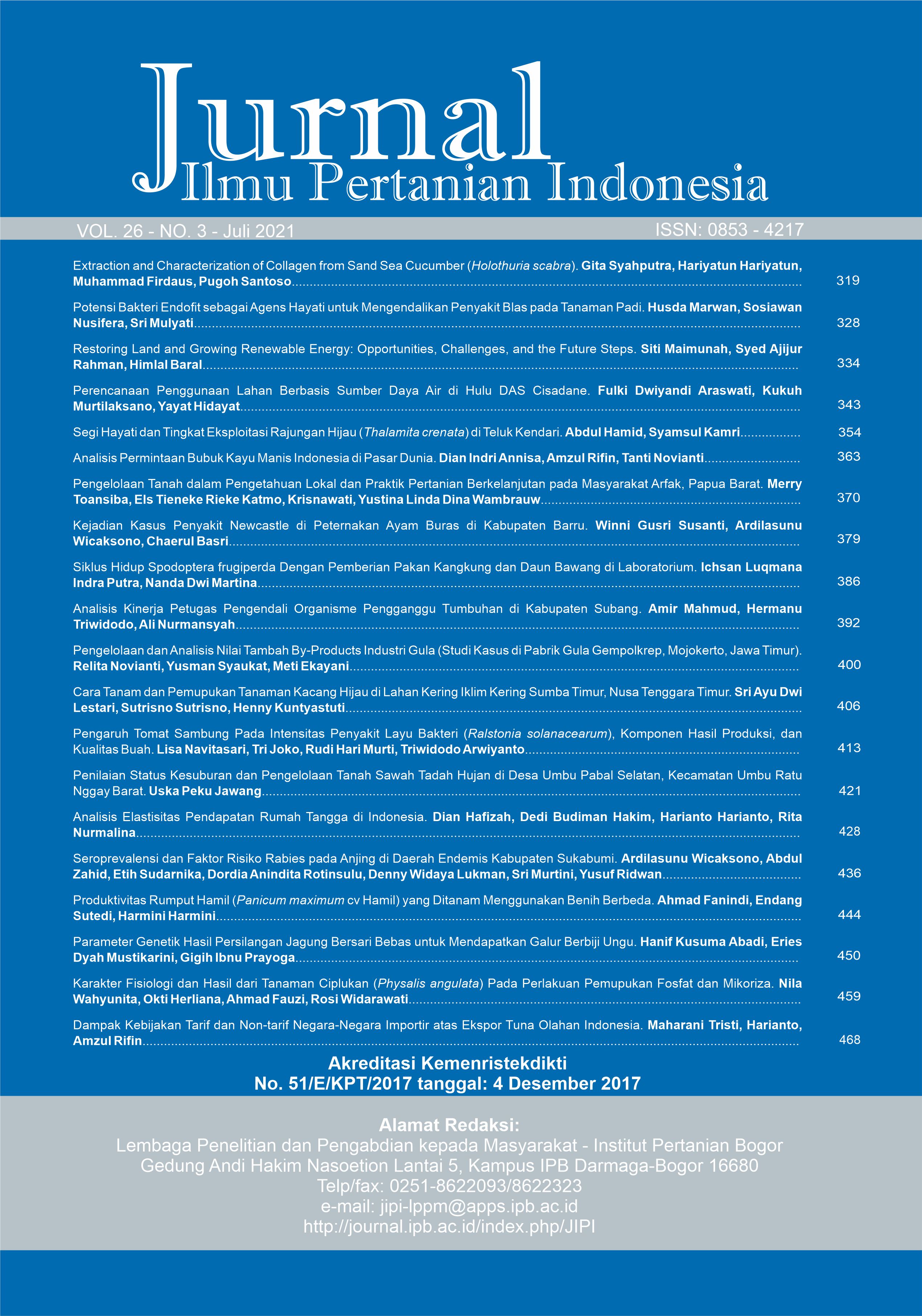Produktivitas Rumput Hamil (Panicum maximum cv Hamil) yang Ditanam Menggunakan Benih Berbeda
Abstract
Reproductive traits determine the selection method in plant breeding. The benggala grass of the Hamil cultivar was thought to be apomictic; thus, a study was conducted to determine its reproduction. The research began by studying the morphological characters, continued with observing the generative phase and seed production of the cultivar planted from seeds (generative) and from pols (vegetative). The experiment was conducted in the greenhouse of the Research Institute of Animal Production. The experimental design was a completely randomized design with ten replications, and the treatments were different types of plant materials: seeds and pols. The Hamil cultivar taken from RIAP Collection was planted in pots with a diameter of 40 cm and a height of 30 cm. The results showed that most of the morphological characters of the Hamil cultivar planted from seeds and from pols were not different (P >0.05), so it was presumed that they were apomictic. The difference in morphology was only in the length and width of the flag leaves and the length of the internodes, where the cultivars planted using seeds were higher. The production of seeds, pithy seed weight, and seed germination of cultivars planted using seeds were higher (P <0.05). Further research is needed to determine the apomixis properties based on cytologically Hamil cultivars.
Keywords: apomixis, benggala grass, morphology, plnting material; seed
Downloads
References
Al-Tahir FMM. 2014. Flag leaf characteristics and relationship with grain yield and grain protein percentage for three cereals. J Medicanal Plants Stud. 2(5):1–07.
Ali M, Hussain M, Khan MI, Ali Z, Zulkiffal M, Anwar J, Sabir W, Zeeshan M. 2010. Source-sink relationship between photosynthetic organs and grain yield attributes during grain filling stage in spring wheat (Triticum aestivum). Int J Agric Biol. 12(4):509–515.
Alvarenga CAF, Euclides VPB, Montagner DB, Sbrissia AF, Barbosa RA, De Araújo AR. 2020. Animal performance and sward characteristics of mombaça guineagrass pastures subjected to two grazing frequencies. Trop Grasslands-Forrajes Trop. 8(1):1–10.
Atherton DO. 1963. Personal communication. Brisbane(AU): Dep. Agric. and Stock, Brisbane.
Chen L, Nishimura Y, Umeki K, Zhang J, Xu C. 2015. Establishment of a Simple Plant Regeneration System Using Callus from Apomictic and Sexual Seeds of Guinea Grass (Panicum maximum). BBJ. 7(4):183–190.
Cho LH, Yoon J, Gynheung A. 2017. The control of flowering time by environmental factors. Plant J. 90:708–719.
Clements RJ, Henzell EF. 2010. Pasture research and development in northern Australia: An ongoing scientific adventure. Trop Grasslands. 44(4):221–230.
Conner JA, Ozias-Akins P. 2017. Apomixis: engineering the ability to harness hybrid vigor in crop plants. Methods Mol Biol. 1669:17–34.
Hand ML, Koltunow AMG. 2014. The genetic control of apomixis: Asexual seed formation. Genetics. 197(2):441–450.
Hare MD, Phengphet S, Songsiri T, Sutin N, Stern E. 2013. Effect of cutting interval on yield and quality of two Panicum maximum cultivars in Thailand. Trop Grasslands-Forrajes Trop. 1(1):87–89.
Hare MD, Sutin N, Phengphet S, Songsiri T. 2018. Germination of tropical forage seeds stored for six years in ambient and controlled temperature and humidity conditions in Thailand Germinación de semilla de forrajeras tropicales durante seis años de almacenamiento bajo condiciones ambientales y condicio. Trop Grasslands. 6(1):26–33.
Heidari H. 2017. Source-sink manipulation effects on wheat seed yield and seed germination characteristics. Biharean Biol. 11(1):33–36.
Hu C, Rao J, Song Y, Chan SA, Tohge T, Cui B, et al. 2020. Dissection of flag leaf metabolic shifts and their relationship with those occurring simultaneously in developing seed by application of non-targeted metabolomics. PLoS One. 15(1).
Jank L, De Lima EA, Simeão RM, Andrade RC. 2013. Potential of Panicum maximum as a source of energy. Trop Grasslands-Forrajes Trop. 1(1):92–94.
Kaushal P, Dwivedi KK, Radhakrishna A, Saxena S, Paul S, Srivastava MK, Baig MJ, Roy AK, Malaviya DR. 2018. Ploidy dependent expression of apomixis and its components in guinea grass (Panicum maximum Jacq.). Euphytica. 214(9):4–6.
Madic M, Knezevic D, Paunovic A, Durovic D. 2016. Plant height and internode length as components of lodging resistance in barley. Acta Agric Serbica. 42(12):99–106.
Ozias-Akins P. 2006. Apomixis: Developmental characteristics and genetics. CRC Crit Rev Plant Sci. 25(2):199–214.
Rahman M, Haque M, Sikdar B, Islam M, Matin M. 2014. Correlation Analysis of Flag Leaf with Yield in Several Rice Cultivars. J Life Earth Sci [Internet]. 8:49–54. 10.3329/jles.v8i0.20139.
Ramakrishnan P, Babu C, Iyanar K. 2014. Genetic Diversity in Guinea Grass (Panicum maximum Jacq.) for Fodder Yield and Quality using Morphological Markers. Int J Plant Biol Res. 2(1):1–4.
Suroso B, Sodik AJ. 2016. Potential and contribution of the results agronomic crop soybean ( Glycine max L . Merrill ) on monoculture cropping system ] Agritrop Jurnal Ilmu-Ilmu Pertanian. Agritop J Ilmu-ilmu Pertan.:124–133.
Tambal HAA, Erskine W, Baalbaki R, Zaiter H. 2000. Relationship of flower and pod numbers per inflorescence with seed yield in lentil. Exp Agric. 36(3):369–378.
UPOV. 2006. International Union for The Protection of New Varieties of Plants. Ryegrass. Guidelines for The Conduct of Tests for Distinctness, Uniformity and Stability [Internet]. https://www.upov.int/ edocs/tgdocs/en/tg004.pdf
Walsh SR. 1959. Improved pastures will fatten cattle in far North. Qd agric J. 85:576–592.
This journal is published under the terms of the Creative Commons Attribution-NonCommercial 4.0 International License. Authors who publish with this journal agree to the following terms: Authors retain copyright and grant the journal right of first publication with the work simultaneously licensed under a Creative Commons Attribution-NonCommercial 4.0 International License. Attribution — You must give appropriate credit, provide a link to the license, and indicate if changes were made. You may do so in any reasonable manner, but not in any way that suggests the licensor endorses you or your use. NonCommercial — You may not use the material for commercial purposes.






















